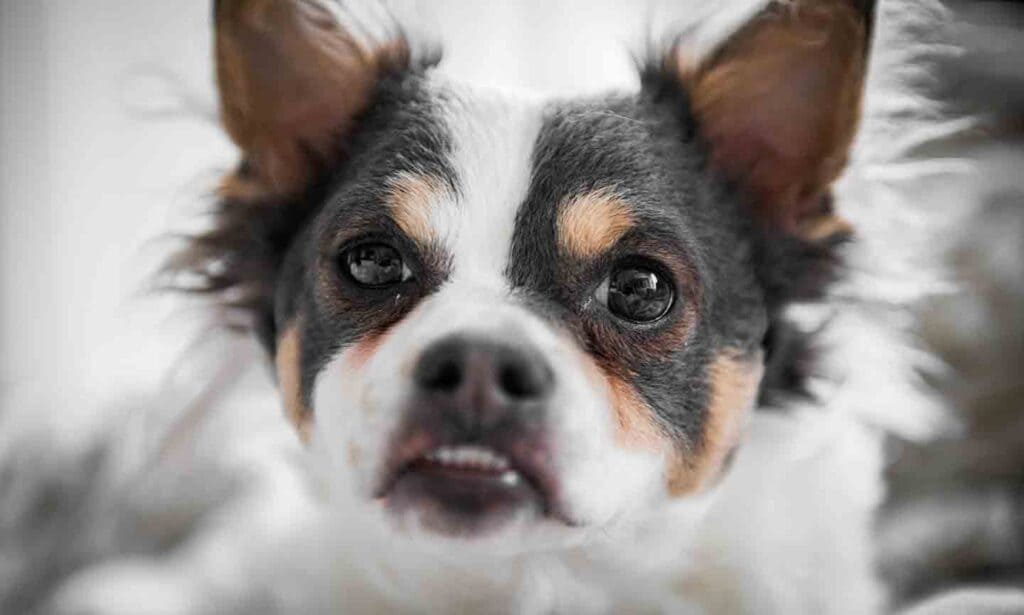Did you know dogs can experience all the same eye problems as humans? It’s true!
One of the most common eye problems veterinarians see is dog eye discharge or eye boogers. Dog eye discharge has a variety of causes, and it may be totally normal—or it could signify a medical problem that needs veterinary attention. We’re covering everything pet parents need to know about dog eye discharge, including the signs, diagnosis, treatment, and prevention.
In This Guide:
What Does Dog Eye Discharge Look Like?
The appearance of the eye discharge depends on what kind of discharge the dog is experiencing.
Types of Dog Eye Discharge
Dog eye discharge comes in several varieties, and some are more serious than others. Some types of dog eye discharge require treatment, while others may be normal for your dog. Types of dog eye discharge include:
- Normal, tan-colored sleep crusts that accumulate in the interior corner of a dog’s eye while sleeping
- Clear tears that spill out of your dog’s eye
- White discharge, associated with inflammation or irritants of the eyeball or conjunctiva (the pink tissue that lines the inside of the eyelids and surrounds the eye)
- Yellow or green discharge associated with eye infections
- Bloody discharge associated with ocular trauma
If you notice out-of-the-ordinary eye discharge in your dog, even if it is just clear tears, get it checked out by your veterinarian to make sure it isn’t something serious that can cause pain or loss of vision.
When To Worry About Dog Eye Discharge
Dogs can get “sleepies” just like humans do. Rest assured that a small amount of crusty accumulated discharge in the interior corner of a dog’s eyes after sleeping is considered normal as long the dog does not have any squinting, redness or other ocular abnormalities.
Eye discharge is a problem if the following symptoms are also noted:
- Tearing is so excessive that it looks like the dog is crying and tears are staining the fur around the eyes.
- Discharge is green, yellow, white, or red.
- The third eyelid is elevated or swollen, or the dog has a cherry eye (swollen tear gland in third eyelid).
- Dog’s eyes are also red or cloudy.
- Dog is also squinting, pawing at their face, or sneezing excessively.
- The eyeball or eye socket appears swollen.
- You’re noticing a white color in the dog’s pupil (black center of eye).
- Your dog has hair or eyelashes that stick to the surface of the eye (cornea).
- You’re noticing changes to the white or colored part of your dog’s eye.
- Your dog is showing signs of blindness or vision changes, like bumping into objects.
- Your dog shies away from having their head touched.
- Your dog's eyelids roll in or out or have a growth on them.
- Your dog has other signs of illness like vomiting, low energy level, or abnormal behavior.
In these cases, call your veterinarian and have your dog seen as soon as possible. Some eye conditions can cause blindness or loss of the eyeball if not treated immediately, so it is always best to take your dog to the vet as soon as you can.
How Veterinarians Diagnose the Cause of Dog Eye Discharge
A veterinarian will utilize several strategies to determine the cause of your dog’s eye discharge. First, the veterinary care team will take your dog’s vitals (body weight, temperature, heart rate, and breathing rate) and ask you a series of questions to get a history. Then, the veterinarian will conduct a full physical examination of your dog’s body and a specialized ophthalmological examination of your dog’s eyes.
An ophthalmological examination may include:
- Visual examination of the eyes
- Checking cranial nerve reflexes (large nerves from brain to other parts of body including the eyes and face)
- Vision checks (usually done by dropping a cotton ball in front of a dog)
- Using special equipment and lights to examine the surface and interior of the eyeball
- Checking the pressure of the eyeballs with tonometry equipment for glaucoma
Depending on what the vet finds on the ophthalmologic examination, they may want to run additional eye tests, which can include:
- Fluorescein eye stain to check for corneal ulcers or injuries on the surface of the cornea
- Schirmer tear test to check for adequate tear production
Based on the exam and test findings, most general veterinarians can diagnose the cause of eye discharge and recommend treatment. In some cases, a veterinarian may not be able to diagnose or treat an eye problem, so you may be referred to a veterinary ophthalmologist for further care.
How To Treat Dog Eye Discharge
As already stated, a small amount of eye discharge that accumulates in the corner of the eye after sleeping is normal and does not require treatment. Otherwise, treatment of dog eye discharge varies depending on the diagnosed cause. Treatments may include:
- Antibiotic drops or ointments
- Steroid or immunosuppressant drops or ointments
- Pain medications
- Surgical correction of deep ulcers, eyelid abnormalities, cataracts, or other conditions
- Eye drops or ointments to control pressure in the eye
- Artificial tears
- Trimming fur away from the eyes and freezing away abnormal eyelashes
Your veterinarian will recommend the best treatment for your dog’s eye discharge. By following their recommendations, you give your dog the best chance of maintaining their eyesight; reducing pain if present; and resolving the underlying issue.
If your dog has a corneal ulcer or eye injury, your veterinarian may also recommend a recovery cone to stop your dog from rubbing their eye.
How To Apply Dog Eye Medication
Before applying eye medication to your dog’s eyes, collect all the medications you will need and carefully read the instructions. If your dog needs more than one eye medication, organize the medication lids so they go back on the right medication after you use them. You can either leave the tops on until you use the medication then immediately replace the top, or leave the lid/top in a place that will prevent confusion.
It is helpful to apply eye medication right before feeding your dog in the morning or evening. If your dog associates the eye medication with their daily meal (or a treat), they will be more cooperative. Make sure to have their food ready in a bowl or a small treat nearby, then follow these steps:
1. Prepare To Administer the Medication
Choose a location where you can calmly and safely control your dog, away from other dogs. Breathe and relax: Remember, your dog can pick up on your anxiety! Once you are calm, call your dog over or pick them up. Speak softly and reassuringly to your dog, and give them some pets and snuggles.
If you have a small dog, hold them in your lap. If you have a medium or large dog, stand with your dog between your legs, or if you have a helper, they can hold your dog while you apply medication.
2. Hold Your Dog’s Head
If you are working alone, place your dominant hand that is holding the medication on your dog’s head to stabilize your hand and prevent accidentally poking your dog in the eye with the medication.
3. Lift Your Dog’s Eyelid
Firmly but gently hold your dog’s head close to your body, and speak reassuringly while you use the same hand that is holding the medication to lift your dog’s upper eyelid.
Most dogs don’t like to see medication bottles coming straight toward their eyes, so try and approach their eyes with the medication from the side.
Use your other hand to gently pull down the lower eyelid to create a little pouch where you can drop the medication.
4. Apply the Medication
Squeeze the eye drops or a ¼-inch strip of eye ointment into the pouch created by pulling down the lower eyelid, then let your dog close their eyes.
If you miss, no big deal. Just try again.
5. Tilt Your Dog’s Head Up
Tilt their head up for a couple of seconds to allow the medication to spread across the eye. If you are using eye ointment, gently massage their eyelid with their eye closed (as long as their eye isn’t painful) to melt and spread the medication, then release your dog.
6. Reward Your Dog
Give your dog praise, pets, and a small treat or meal for being so good!
Note that your dog’s vision will likely be blurry for a few moments after you apply the medication, so watch them for a minute or two to make sure they don’t fall downstairs or bump into anything.
If you can’t get your dog still enough to get the medication into the eye; if your dog’s eye seems irritated after you apply the medication; or the eye condition doesn’t seem to be improving, call your veterinarian for advice.
More Tips and Tricks
- If you are using eye ointment, keep the tip of the container pointed away from your dog’s eye while applying ointment. This is to avoid injury in case your dog jerks their head.
- Avoid letting the tip of the bottle or tube touch any part of your dog’s eye. Touching your dog’s eye with the eye medication container can injure your dog’s eye and contaminate the medication.
- If your dog has been prescribed eye drops, follow all instructions exactly as written, and store the medication as directed. Some eye drops need to be refrigerated or shaken before use.
- Do not stop giving the medication early, even if your dog seems to be better.
- If your dog is receiving multiple eye medications, the order often matters. Check with your veterinarian about the order to give medications and make sure to wait five minutes between each eye medication.
- If you notice your dog has eye discharge and you already have eye medication in your possession, do not give this medication without first consulting with your veterinarian. If it is expired, it will not benefit your dog, and if it is the wrong medication it can make the problem worse.
Preventing Dog Eye Discharge
While it is not possible to prevent all causes of dog eye discharge, there are still things a pet parent can do to improve their dog’s eye health and reduce the likelihood of eye problems or a vision-threatening ocular emergency.
If your dog has excessive eye discharge due to seasonal allergies, for example, ask your vet about antihistamine therapy and how to rinse allergens out of your dog’s eyes with sterile saline solution. Keep your dog up to date on their vaccines to prevent upper respiratory diseases that can cause eye discharge.
In general, if you notice your dog is tearing excessively, squinting, or their eye is red or looks funny, take your dog to a veterinarian as soon as possible.
This content was medically reviewed by a veterinarian.
What Does Your Dog See?
Share:











